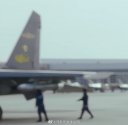it doesn't - because it won't let you have any advantage in number of missiles. This is impossible if fighters enter the engagement (and engage in a normal sequence), and they do (and in fact launch at targets they see, either on their own or through datalinks). You simply bring more fighters - this isn't trucking. Pure fighter force(lo and non-lo mix, doesn't matter) can be just as interlinked, it's the basis of fighter tactics for decades by now.
This entirely depends on the mission profile of the missile trucks in question.
Whether they “engage” the enemy or not entirely depends on their ingress and egress before and after they launch their missiles respectively.
Flankers with a heavy BVRAAM load for example can remain many hundreds of kms behind the anticipated line of engagement where your more VLO aircraft operate, and then as the situational awareness picture develops or if your forward VLO aircraft require it, your missile truck Flankers can move forwards to launch their BVRAAMs at the opfor targets that your networked friendly aircraft designate and then immediately get out of dodge the moment they launch their weapons.
I consider that very much a missile truck role and it doesn’t necessitate your missile truck platform to have 400km BVRAAMs or be invulnerable to enemy attack as part of their mission.
More survivable LO fighters will be doing the same thing with more or less the same numbers of weapons - just somewhat closer. x-band stealth supported by offboard EW is ultimately superior survivability solution to good onboard EW (and Chinese 4th gen fighters don't really overly specialize in it either).
To be considered an actual truck - "trucker" must bring into the fight ammunition which otherwise wouldn't be in it (very long range missiles with significant overmatch over normal ones). Preferably - in numbers unachievable by just adding some more fighters with their normal OFCA loadouts.
Because otherwise it isn't truck, it's just a normal fighter - there is no "delivery" in their job. Or, alternatively, every fighter in the air with at least one missile is a truck - and then the term loses any remaining sense.
Idea of missile truck is to bring more into the force, by specifically distributing roles: some fighters(LO, better - VLO) do the sensing/guidance part, some take disproportionate amounts of A2A weight(size of munitions, number of munitions) - which would've made them extremely vulnerable otherwise. "Truck" is a survivability/capability sacrifice for the common goal. But because they in principle operate outside of the reach of OPFOR - they can do it nonetheless.
Net result is that such a distributed force is meant to have more missiles than 'all fighter' one, in the best case scenario - deadlier missiles better supported through the flight till going active.
You almost had it lol.
Yes, every fighter in the air with at least one missile by definition can be considered a missile truck, and I think that is an excellent way of viewing it.
In a given engagement, it is the mission profile of the fighter with one or more missiles that should primarily determines whether it is a missile truck or not, rather than armament alone.
I view a missile truck as an aircraft which does not engage the enemy fighters in a direct fashion but instead loiter behind the anticipated line of engagement and dash forwards occasionally to provide support to one’s own fighters that are engaged, in the form of moving forwards to launching missiles networked and supported by friendly assets, and to immediately egress after launching its payload.
In other words, any fighter whose role is to carry one or more missiles while loitering, and whose mission is essentially limited to dashing forwards to launch its missiles at the enemy and immediately running away to get out of there, can fulfill the role of a missile truck.
I have never seen any definition of a missile truck that necessitated it to carry a weapon that particularly outranged the enemy. Obviously it would be nice if it had a weapon with such capabilities, but the lack of such a weapon that outranged the enemy does not mean a platform cannot be a missile truck. Instead, it is the mission profile which is the common denominator for this role.


